For many reasons, olive oils are good for your health. It improves the digestive system, reduces inflammation, prevents cancer, moisturizes hair, and more.
The 5 types of olive oils are extra virgin, virgin, pure, refined, and pomace. Each type has its distinct benefits, flavors, colors, and usage.
Before rushing to the store to buy olive oil, you must understand the different grades of olive oil and their purposes and benefits.
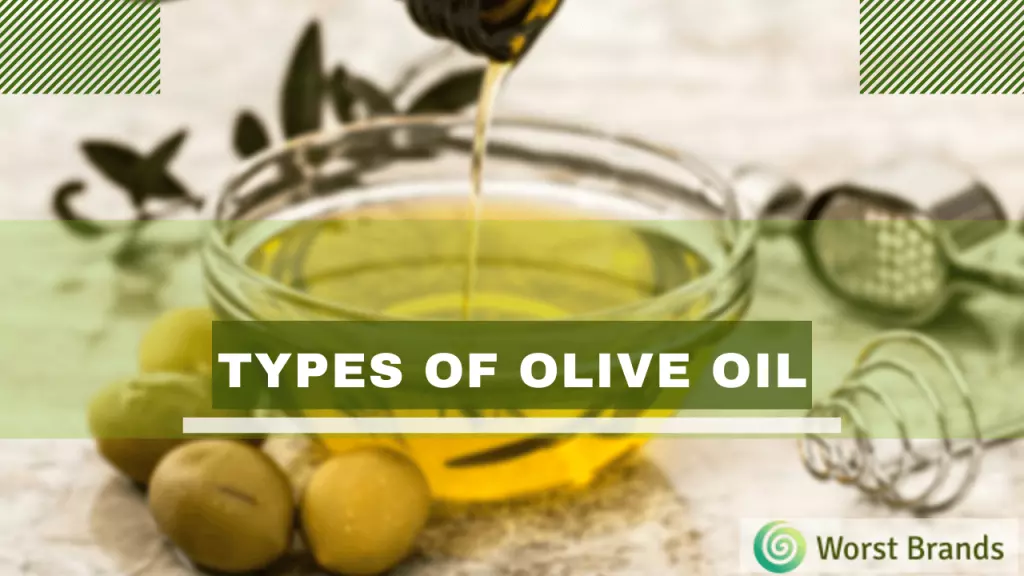
Table of Contents
- What is Olive Oil?
- How Olive Oil is Made?
- 1. Process of Olive harvesting
- 2. Washing Process
- 3. Pressing of olives
- 4. Extraction of Oil Juice
- 5. Quality control of olive oil
- 6. Packaging
- Types of Olive Oil
- 1) Extra Virgin Olive Oil (EVOO)
- 2) Virgin Olive Oil
- 3) Pure Olive Oil
- 4) Light Olive Oil
- 5) Pomace Olive Oil
- Types of Olive Oil for Cooking
- Types of Olive Oil for Skin
- Types of Olive Oil for Hair
- Types of olive oil for hair growth
- Types of Olive Oil for Massage
- Type of Olive Oil for Salad
- Frequently Asked Questions
- What is cold-pressed olive oil?
- What is the highest grade of olive oil?
- What is olive oil made of?
- How long does olive oil last?
- Final Words
- Steven Settles
What is Olive Oil?
Olive oil is sodium-free, gluten-free, cholesterol-free, and sugar-free. It is rich in vitamins E and K.
The monounsaturated fats in olive oil may help reduce bad cholesterol and increase good cholesterol. It contains 119 calories per tablespoon and also 14 grams of healthy fat.
Now, first, check out how olive oil is made and which country has the most olive trees. After that, I will let you know the different types of olive oils and their uses.
How Olive Oil is Made?
The history of olive oil is almost 6000 years old. There are several countries popular for olive oil production.
Some top countries include Italy, Greece, Spain, Tunisia, The United States of America, Egypt, Morocco, Portugal, and France.
However, Spain is a big producer of olive oil, with over 300 million olive oil trees.
Its region Andalusia has over 70 million olive oil trees, which produces as much olive oil as the whole of Italy. In fact, Spain produces half of the olive oils sold in the world.
Olive oil is indispensable in any modern kitchen to enhance the taste of food. However, various grades and flavors are available, and each type of olive contains its unique flavor.
By combining different types of olives, the producer can create an oil with an individual flavor.
Check the following steps on how olive oils are made.
Read our following blogs for expert reviews on different olive oil brands:
- Is Oleev Pomace Olive Oil Good?
- Eridanous Olive Oil Review – Is It Real or Fake?
- Is Squeaky Gate Olive Oil Pure?
- Borges Olive Oil Review – Is It Legit?
1. Process of Olive harvesting
The process begins with the harvest. The traditional method involves connecting olives using tiny rakes, but it is time-consuming and failed for big farms.
To harvest efficiently, producers use automated harvesting machines to make the harvest process quick and effective.
These machines hold each tree, shake the olives off the branches, and collect them into a big bucket.
A machine can collect as many olives in an hour as it would take a farmer to collect in a whole day.
Making great olive oil is a race against time. The fruits begin to degrade once it is picked.
So, the producers try to move it from the field to the mill in under 3 hours. The heat is the biggest enemy of flavor.
2. Washing Process
After harvesting, cleaning the fruits is the next process.
When the harvested fruits arrived at the mill, they go through the cleaning and washing process before moving to the production plant.
The collection process removes all the dirt and separates the olives from branches or twigs.
After that, the grill ensures all branches and twigs’ filtration, allowing only the fruit to pass through.
3. Pressing of olives
After the harvest, the fruit must reach the pressing process as soon as possible. The reason is that olives are susceptible to heat and sunlight.
There are two methods of grinding the olives. The traditional method uses big stones to grind fruit into a thick pulp.
However, the modern grinding process carefully controls two essential factors.
First, it sends the fruit directly from the harvester to the grinders to avoid any delay.
Secondly, it grinds the fruit more gently. Olives can lose flavor if the friction of grinding heats the fruit. If the fruit pulp goes over 27 degrees, it can lose its flavor.
This process of grinding is called cold-pressed.
4. Extraction of Oil Juice
The extraction process also has two methods: traditional and modern.
In the traditional extraction system, the pulp layers are in a stack following each pulp layer.
The stack then goes into a hydraulic press, which squeezes the pulp’s oil out. The traditional color is golden green, which indicated high quality.
However, the modern method is far less aggressive but as effective as the traditional. The pulp spins in a centrifuge to crush and extract the oil from the fruit.
As it spins around, the oil passes out through a fine mesh and leaves the pulp behind.
5. Quality control of olive oil
Once it is pressed and extracted, the oil is tested for quality assurance.
The experts perform this task by drinking a fresh oil sample to check the purity and flavor of their product.
Pure and unfiltered oil is the most valuable and healthy to consume.
On the contrary, filtered and refined oil is considered inferior because it has a neutral flavor and color.
6. Packaging
The packaging process of the olive oil is the final most important step.
The best way to pack the bottles is in dark glass to avoid UV light that can cause oil to deteriorate.
Many local stores place these bottles on the top shelves under bright fluorescent lights. So, the dark green glass protects the oil from degrading.
Finally, there is a siphoning and labeling process. A good olive oil brand always mentions the harvest date on the bottle.
On average olive oil, can last up to 24 months from the harvest date.
Types of Olive Oil
The followings are the most common types of olive oil that you should.
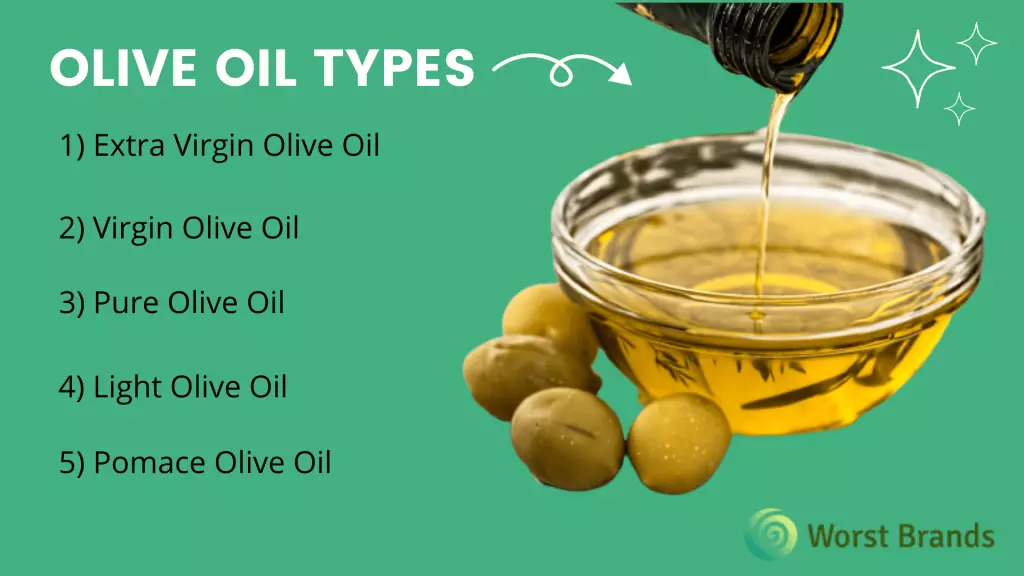
1) Extra Virgin Olive Oil (EVOO)
This is the most expensive type of olive oil as it is a fresh juice of the highest quality olives. Extra virgin oil is completely unrefined.
It is cold-pressed, and this method prevents the natural content from chemical alteration and heat exposure.
It has a mellow and light taste, which gives you a sweet and fruity aroma of freshness.
Extra virgin is very rich in antioxidants and has the highest amount of minerals and vitamins found in olives.
The color of EVOO is golden-green or greenish-yellow depending on the quality of the olives used. For health benefits, extra virgin is the most commonly used olive oil.
This oil is so good and tasty that you can consume or even drink it without adding any other ingredients because the oil’s health benefits are great.
Salad dressing, dipping oil, and seasoning oil are the best way to consume extra virgin.
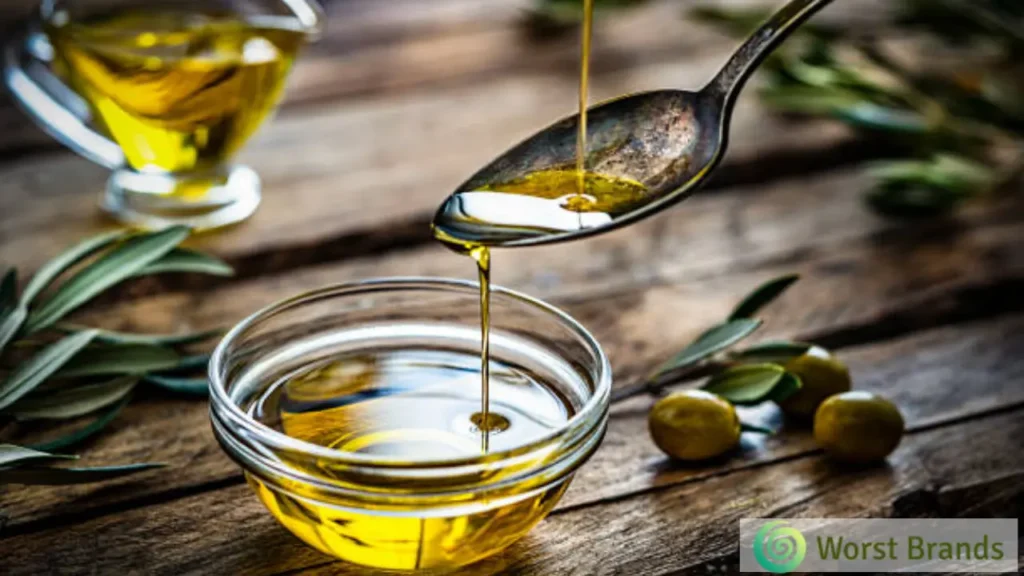
2) Virgin Olive Oil
Make sure not to confuse it with extra virgin olive oil.
However, virgin olive oil is rare to find, even at your local grocery stores. It is very similar to the EVOO with a few minor variations. When buying, beware of the fake brands of olive oil.
The Virgin olive oil is in unrefined form but a little more processed than EVOO. After cold pressing, virgin oil brings a more natural aroma and flavor than the other types.
It contains an acidity content between 1 to 4 percent, which is slightly higher than EVOO.
Virgin oil is the only type that is temperature resistant as well. Compared to the extra virgin. It has a milder taste suitable for low-heat cooking purposes.
The best way to consume it are marinades, baking, light frying, roasting, and sautéing.
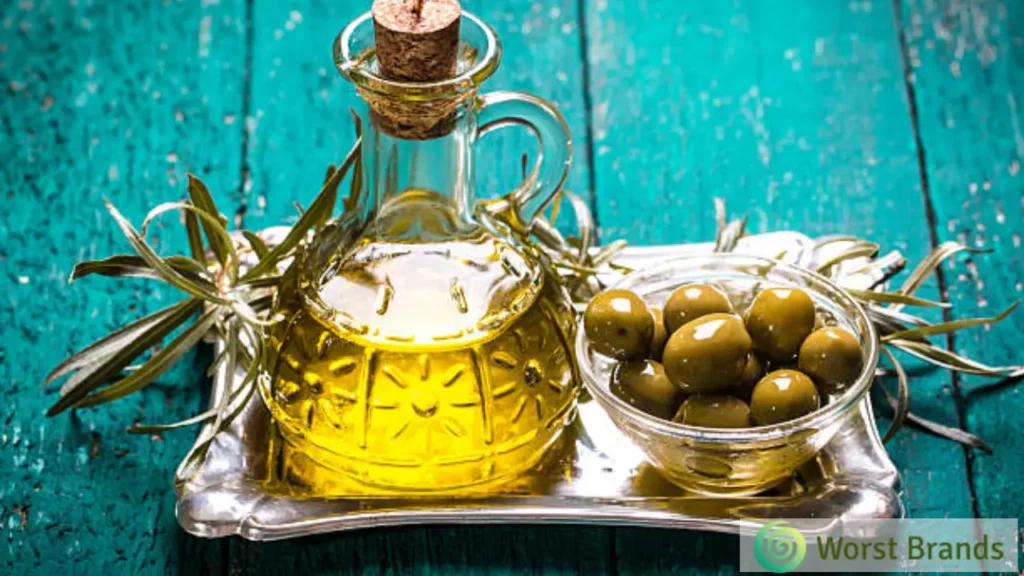
3) Pure Olive Oil
As its name suggests, many people mistakenly believe that it is a pure form of olive oil, but it is not. Pure olive oil is of lower quality than virgin and extra virgin types of oil.
It is less flavorful and lighter in color. Also, it contains higher oleic acid levels ranging from 3 to 4%.
In fact, it is a mix of extra virgin or virgin types with a refined form of olive oil. When the extraction quality is not up to the standard, a mixing method helps to maintain it.
So, the refined oil blends with a better quality one. The added oil will give a higher amount of Vitamin E and a better flavor.
Pure olive oil is best for cooking, body massages, and preparing herbal oils.
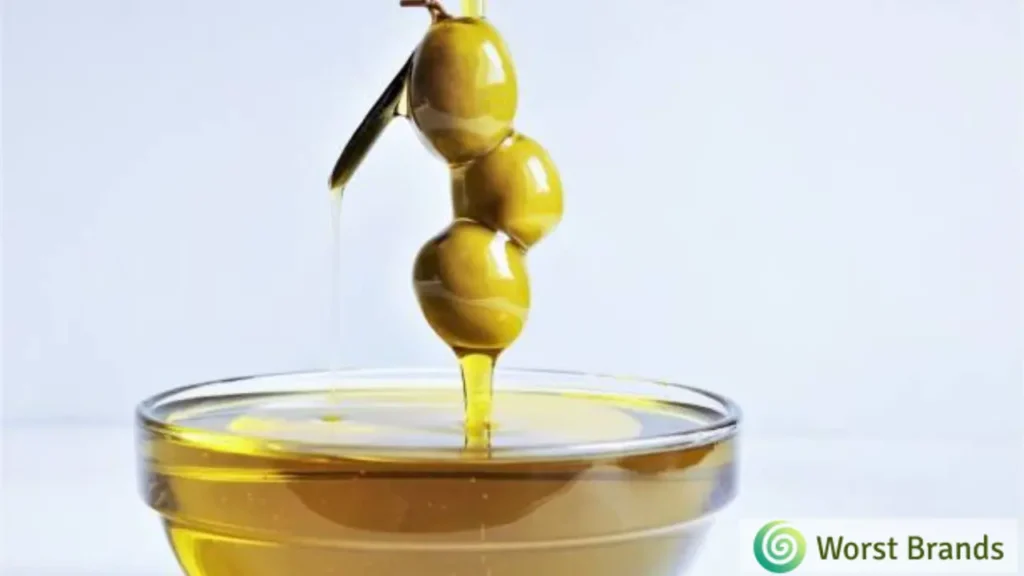
4) Light Olive Oil
Light olive oil is a refined and filtered oil produced by using heat. It is produced from black and ripe olive fruits.
This type is a blend of pure olive oil and 5% to 10% of virgin olive oil. The extra light type has the least amount of virgin oil compared to other types.
Therefore, it is flavorless, light in color, and less in taste.
Don’t confuse “light” with low calories, and it is only light in flavor. It has the same calorie content as other grades.
Many marketing campaigns promote the light olive better than the regular one, but it is of low quality and only good for cooking purposes.
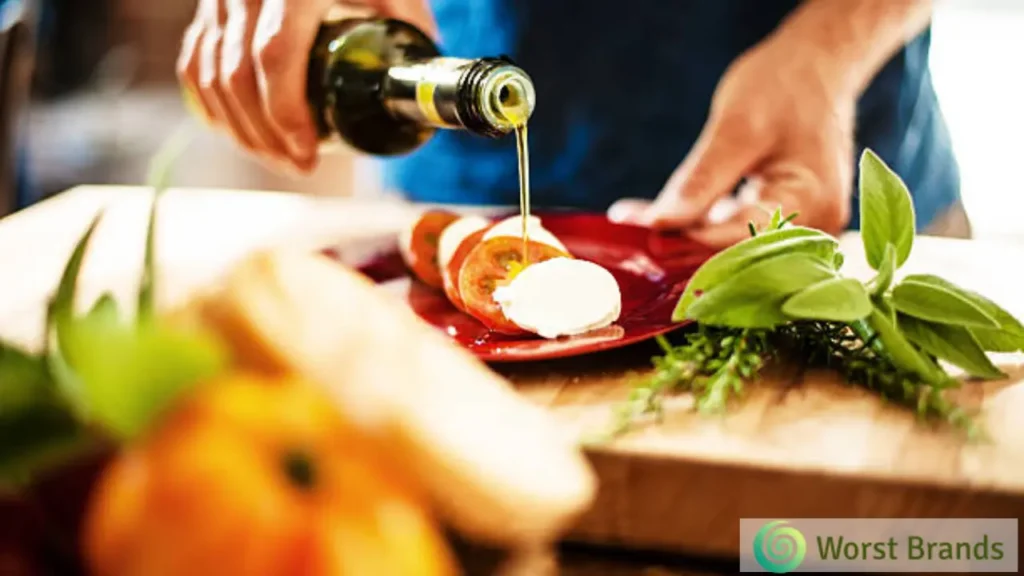
5) Pomace Olive Oil
Along with light, pure, and extra virgin types, it is another form of olive oil prevalent at grocery stores.
Pomace is the lowest quality olive oil. It is extracted from the olive fruit, skin, and pit residue after the first press.
The olive pulp leaves residue containing oil and water. After that, more oil is extracted from them, which is of inferior quality.
The pomace oil is best used for cleaning purposes, such as polishing furniture, etc. However, it is not good for eating purposes.
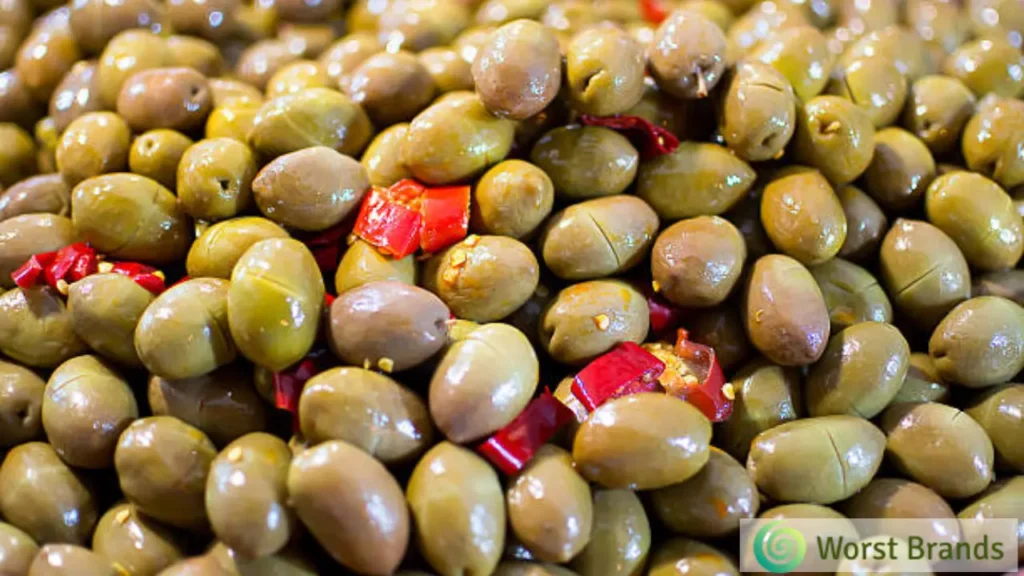
Types of Olive Oil for Cooking
There are five common types of olive oil. All of them are best for cooking except pomace oil.
Many arguments say that pomace oil is also edible, but the fact is that pomace is extracted from the residue of olive pulp and is the most processed oil.
So, it is one of the lowest-quality olive oil.
Furthermore, refined pomace oil includes a high amount of fats but doesn’t contain natural antioxidants.
Before buying pomace oil for eating purposes, consult with a health expert for better guidance.
The following types are good for cooking.
| Type | Smoke Point |
|---|---|
| Extra Virgin Olive Oil | 375 °F |
| Virgin Olive Oil | 410 °F |
| Pure Olive Oil | 390–470 °F |
| Light or Extra-light olive oil | 405 °F |
Types of Olive Oil for Skin
There are a lot of ways to make olive oil more beneficial for the skin. One way is through skincare products.
But most people prefer using olive oil as a moisturizer. It is important to know which type of olive oil is best for your skin before heading to the store.
There are various types of olive oils, and each type has different properties.
However, the best type of oil for skin care is the one that contains the most monounsaturated fats.
Those fats have been proven to be very beneficial for the skin because they help prevent dryness and encourage better hydration.
Olive oil also contains many other good things for your skin. Still, those other components work together with the Monounsaturated fatty acids (MUFAs) to create an unbeatable combination for healthy skin.
But what exactly makes olive oil so great for skin? Let’s take a look at some of the key reasons why:
- It provides excellent moisturization for the skin. One of the biggest problems people have when their skin becomes dry is more prone to irritation.
- It has a high content of vitamins and antioxidants. Antioxidants are important for the skin because they help protect against sun damage. They also work together with the other components in olive oil to promote healthy-looking, smooth skin.
- It prevents wrinkles. Olive oil not only helps moisturize the skin but also reduces fine lines and wrinkles. This is especially true if you use it along with other beneficial ingredients such as vitamin E.
- It enhances the look of scars. For ages, olive oil has been used to enhance the look of old scars. It works because it increases collagen production in the skin, which tightens up the scar tissue.
- It helps prevent infections. For this reason, olive oil is often added to first aid kits. It has antimicrobial properties and can be applied directly to cuts, scrapes, and even acne.
Types of Olive Oil for Hair
Olive oil is used for many purposes, but it is a natural conditioner for hair.
The most common types of olive oil are cold-pressed virgin olive oils with no additives or refined oils that have been blended or processed to change the chemistry of the oil.
Many types of olive oils are good for your hair. But if you want to find out which type will work best with your hair, start by examining the label.
Olive oils labeled “cold-pressed” usually contain higher antioxidants and polyphenols than those with “refined” labels. If you suffer from dry scalp or dandruff, try an extra virgin cold-pressed olive oil instead of a cold-pressed refined oil like extra virgin cold-pressed light.
Types of olive oil for hair growth
There are different types of olive oil for hair growth.
- Olive oil for curly hair: use it as a leave-in conditioner before shampooing to avoid frizz or as part of your styling routine. You can also mix some in with your deep conditioning treatments to keep your curls looking bouncy.
- Olive oil for dry, brittle hair: apply on wet hair, wrap in a towel and leave overnight. When you wake up the next morning, wash and go! Thus, restoring the natural oils to your hair and giving them an all-over softness and shine.
- Olive oil for thick, coarse hair: this one is a bit unusual. The way you use it is by mixing a small amount (about 1/4 cup) with a cup of water and then applying it to your hair as normal. Leave for 30 minutes or so, and then shampoo and condition as usual. Your hair will be incredibly soft, smooth, and manageable.
Types of Olive Oil for Massage
One of the most versatile massage products is olive oil. It contains a unique fatty acid content that dissolves into the skin, leaving it smooth and nourished. Olive oil can also act as an emollient that leaves your skin feeling hydrated, smooth, and silky.
The benefits of olive oil are not only limited to its cosmetic properties but also to its therapeutic qualities.
Depending on the sort of massage you’re doing, there are numerous types of oils with different uses. Below are some oils that may be more appropriate for certain types of massage
- Extra virgin cold pressed olive oil: This type of oil is good for very light massages with light pressure
- Extra virgin cold-pressed almond oil: This type is perfect for deep penetrating massages
Type of Olive Oil for Salad
Olive oil is a versatile product that can be used for various purposes. It is one of the most commonly used oils in the kitchen due to its taste and health benefits.
There are two types of olives: green and black. The green variety has a higher amount of oleic acid, making it a healthier option for salad dressings.
Black olives have a higher level of healthy monounsaturated fats, making them better for deep-frying and roasting than other cooking methods such as grilling or sautéing.
The type of olive oil you should use depends on the type of cooking you will be doing with it.
Frequently Asked Questions
What is cold-pressed olive oil?
Cold pressing is the process of grinding or crushing the extra virgin without any heat or chemical alteration. There are two methods of cold pressing: traditional and modern.
In a traditional way, big stones are used for grinding the fruit. However, modern machines are used for crushing the fruit. Modern technology is better, faster, and more hygienic than the old methods of squeezing oil from the olives.
What is the highest grade of olive oil?
The best grade of olive oil is Extra Virgin. Extra virgin is cold-pressed without any heat or chemical adulteration. It is the fresh juice of the olives.
What is olive oil made of?
The ripened fruit of the olive tree is used to produce olive oil. The extraction process crushes and squeezes the oil from the pulp of the olive. Typically, the color of olive oil is golden green, which indicates good quality.
How long does olive oil last?
Olive oil is susceptible to heat and UV lights, and it can deteriorate before the end of its expiry date if not cared for well. The olive oils can last up to 18 to 24 from the harvest date.
Therefore, always check the bottle’s harvest date instead of the “best by” date to make sure you are not buying rancid olive oil. The best time to use olive oil is two years from the harvest.
Final Words
Understanding the different types of olive oil is imperative because each type has its distinct benefits.
Olive oil tends to raise the standard in kitchens around the world. The extra virgin is premium quality olive oil, which is the most beneficial for health in various manners.
In old traditional methods, olives were ground between stones, and then paste was pressed to squeeze the oil.
Today, a tiny number of producers use this method. However, modern technology has replaced the old method of extracting extra virgin oil with super hygienic facilities.

Steven Settles is an ISCET-certified master in appliance repair. He has aced the National Appliance Service Technician Certification Exam, showcasing his exceptional diagnostic and repair skills. With an in-depth understanding of the latest repair technologies and a keen eye on evolving industry standards, Steven is a go-to expert for any appliance issue.